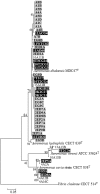Chironomids' Relationship with Aeromonas Species
- PMID: 27242751
- PMCID: PMC4871854
- DOI: 10.3389/fmicb.2016.00736
Chironomids' Relationship with Aeromonas Species
Abstract
Chironomids (Diptera: Chironomidae), also known as non-biting midges, are one of the most abundant groups of insects in aquatic habitats. They undergo a complete metamorphosis of four life stages of which three are aquatic (egg, larva, and pupa), and the adult emerges into the air. Chironomids serve as a natural reservoir of Aeromonas and Vibrio cholerae species. Here, we review existing knowledge about the mutual relations between Aeromonas species and chironomids. Using 454-pyrosequencing of the 16S rRNA gene, we found that the prevalence of Aeromonas species in the insects' egg masses and larvae was 1.6 and 3.3% of the insects' endogenous microbiota, respectively. Aeromonas abundance per egg mass remained stable during a 6-month period of bacterial monitoring. Different Aeromonas species were isolated and some demonstrated the ability to degrade the insect's egg masses and to prevent eggs hatching. Chitinase was identified as the enzyme responsible for the egg mass degradation. Different Aeromonas species isolated from chironomids demonstrated the potential to protect their host from toxic metals. Aeromonas is a causative agent of fish infections. Fish are frequently recorded as feeding on chironomids. Thus, fish might be infected with Aeromonas species via chironomid consumption. Aeromonas strains are also responsible for causing gastroenteritis and wound infections in humans. Different virulence genes were identified in Aeromonas species isolated from chironomids. Chironomids may infest drinking water reservoirs, hence be the source of pathogenic Aeromonas strains in drinking water. Chironomids and Aeromonas species have a complicated mutual relationship.
Keywords: Aeromonas; Chironomus; Vibrio cholerae; chironomid; chitinase; egg mass; virulence genes.
Figures

References
-
- Ali A. (1995). “Nuisance, economic impact and possibilities for control,” in The Chironomidae: The Biology and Ecology of Non-biting Midges, eds Armitage P. D., Cranston P. S., Pinder L. C. V. (London: Chapman and Hall; ), 339–345.
-
- Armitage P., Cranston P. S., Pinder L. C. V. (eds) (1995). The Chironomidae: The biology and Ecology of Non-biting Midges. London: Chapman and Hall.
-
- Beaz-Hidalgo R., Figueras M. J. (2012). “Molecular detection and characterization of furunculosis and other Aeromonas fish infections,” in Health and Environment in Aquaculture, eds Carvalho E. D., David G. S., Silva R. J. (Rijeka: InTech Open Access Publisher; ), 97–132.
-
- Beaz-Hidalgo R., Martinez-Murcia A., Figueras M. J. (2013). Reclassification of Aeromonas hydrophila subsp. dhakensis Huys et al. 2002 and Aeromonas aquariorum Martinez-Murcia et al. 2008 as Aeromonas dhakensis sp. nov. comb nov. and emendation of the species Aeromonas hydrophila. Syst. Appl. Microbiol. 36 171–176. 10.1016/j.syapm.2012.12.007 - DOI - PubMed
Publication types
LinkOut - more resources
Full Text Sources
Other Literature Sources

